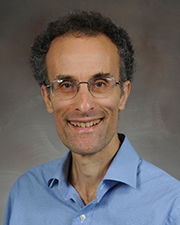Biography
Dr. Margolin grew up in Tenafly, NJ, near New York City. He attended M.I.T. as an undergraduate, where he worked on E. coli genetics research with Graham Walker, and biochemical engineering research on thermophilic clostridia with Daniel I.C. Wang. He then completed his Ph.D. work on transcriptional regulation in bacteriophage Mu with Martha Howe at the University of Wisconsin-Madison. Dr. Margolin followed this with an NSF postdoctoral fellowship in Plant Biology with Sharon Long at Stanford, where he studied the role of FtsZ in cell division of rhizobia.
He joined the Department of Microbiology and Molecular Genetics at UTHealth Houston’s McGovern Medical School in 1993 to begin his long-standing investigation of bacterial cell division and organization.
Education
- Postdoctoral Fellow
- Stanford University
- Ph.D.
- University of Wisconsin, 1989
Areas of Interest
Research Interests
Targeting and assembly of the bacterial cell division complex
Cell division, or cytokinesis, is a fundamental requirement for the proliferation of all cells. Cytokinesis is regulated temporally and spatially to insure that daughter cells contain the normal complement of chromosomes. We study the regulation of cell division in bacteria, which enables us to use highly sophisticated genetic approaches. Despite our vast knowledge of prokaryotic biology, we still understand surprisingly little about how bacteria, such as Escherichia coli, divide by binary fission.
One of the cell division proteins we focus on is FtsZ. FtsZ is an abundant protein that, in response to an unknown signal, polymerizes into a ring structure marking the division site and is essential for the initiation of cell division. Other essential proteins, such as FtsA and FtsK, are then recruited to the FtsZ ring and act in a putative complex to complete division. FtsZ is ubiquitous, with homologs in eubacteria, archaea and chloroplasts. Current evidence suggests that FtsZ is essential to define the cell division plane in all non-nucleated cells. What has made working on these protein even more exciting is that FtsZ and FtsA are homologs of the eukaryotic cytoskeletal proteins tubulin and actin, respectively. In the last few years we have focused particularly on FtsA, as it seems to be a key regulator of the FtsZ ring.
Our long-term goals are to understand how FtsZ and other cell cycle proteins target precisely to the division site, do so only once per cell division cycle, and achieve the constrictive force necessary for cytokinesis. We are also interested in the diversity of cell division mechanisms among microorganisms.
Publications
Robles-Ramos, M., Zorrilla, S. Alfonso, C., Margolin, W., Rivas, G., and Monterroso, B. Assembly of bacterial cell division protein FtsZ into dynamic biomolecular condensates. BBA Mol. Cell. Res. 1868:118986, 2021.
Zorrilla, S., Monterroso, B., Robles-Ramos, M., Margolin, W., and Rivas, G. FtsZ interactions and biomolecular condensates as potential targets for new antibiotics. Antibiotics 10:254, 2021.
Straniero, V., Sebastián-Pérez, V., Suigo, L., Margolin, W., Casiraghi, A., Hrast, M., Zanotto, C., Zdovc, I., Radaelli, A., and Valoti, E. Computational design and development of benzodioxane-benzamides as potent inhibitors of FtsZ by exploring the hydrophobic subpocket. Antibiotics 10:442, 2021.
Pradhan, P., Margolin, W., and Beuria, T.K. Targeting the Achilles Heel of FtsZ: the interdomain cleft. Front. Microbiol. 12:732796, 2021.
Cameron, T.A., Vega, D.E., Yu, C., Xiao, H., and Margolin, W. ZipA uses a two-pronged FtsZ binding mechanism necessary for cell division. mBio 12:e0252921, 2021.
Paccione, G., Robles-Ramos, M.A., Alfonso, C., Sobrinos-Sanguino, M., Margolin, W., Zorrilla, S., Monterroso, B., and Rivas, G. Lipid surfaces and glutamate anions enhance formation of dynamic biomolecular condensates containing bacterial cell division protein FtsZ and its DNA-bound regulator SlmA. Biochemistry 61:2484-2489, 2022.
Cameron, T.A. and Margolin, W. Construction and characterization of functional FtsA sandwich fusions for studies of FtsA localization and dynamics during Escherichia coli cell division. J. Bacteriol. 205:e0037322, 2023.
Monterroso, B., Robles-Ramos, M.A., Sobrinos-Sanguino, M., Luque-Ortega, J.R., Alfonso, C., Margolin, W., Rivas, G., and Zorrilla, S. Bacterial division ring stabilizing ZapA versus destabilizing SlmA modulate FtsZ switching between biomolecular condensates and polymers. Open Biol. 213:220324, 2023.
Naha, A., Haeusser, D.P., and Margolin, W. Anchors: a way for FtsZ filaments to stay membrane bound. Mol. Microbiol., in press, 2023. doi:10.1111/mmi.15067.
Hu, B., and Margolin, W. Probing cytoskeletal oligomers and polymers in the bacterial divisome by electron tomography. Methods Mol. Biol., in press, 2023.
Cameron, T.A. and Margolin, W. New insights into the assembly and regulation of the E. coli divisome. Nat. Rev. Microbiol., in press, 2023.
